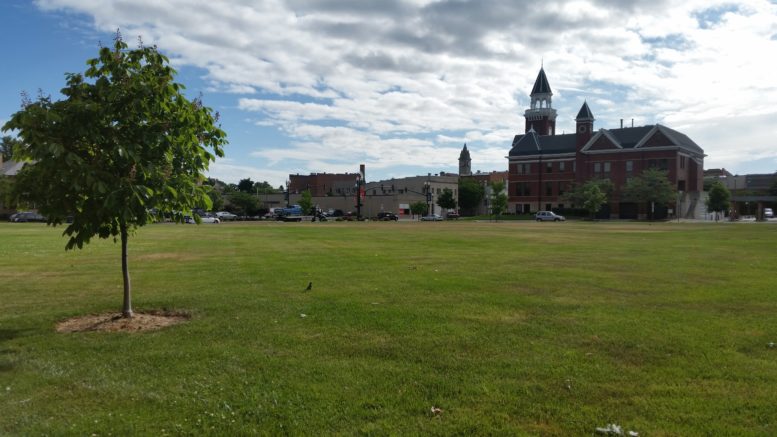By JAN LARSON McLAUGHLIN
BG Independent News
It’s official. “Wooster Green” will remain a green gathering space for Bowling Green citizens for generations to come.
After years of debate, City Council voted unanimously Monday evening to preserve the 1.7 acres at the corner of West Wooster and South Church streets as green space. The vote was met with a round of applause from those in the council chambers.
The action was welcomed by those who spent months planning out a concept for the community space.
“I thought all along it would pass,” Eric Myers, who led the task force to come up with a plan for the property, said after Monday’s council meeting. “Hopefully we can continue the momentum for fundraising.”
Mayor Dick Edwards, a supporter of the green space concept, said he plans to convene the Green Space Task Force on Oct. 11 to discuss the next steps.
The resolution states the property, formerly the site of the city junior high, is to be developed in consideration of the concept design prepared by the Green Space Task Force.
“It’s finally happening tonight,” Council member Sandy Rowland said. “It’s been a great journey. That property has just been waiting” to become a community gathering space.
“I’m supporting this with all my soul and my heart,” she said. “I knew I would support this since the junior high was torn down.”
Rowland said the new community space will help attract families to live in Bowling Green. “We will have a fabulous public space.”
The task force’s plan was originally presented to city council nearly a year ago. But the plan seemed to stall out at that point, and council decided to do further study on the site in case a new city building could share the property with a community green space.
Though the study showed it was possible to combine both a new city building and green space on the acreage, public pressure came from citizens who wanted the site to remain undeveloped, except for a few town square features. Edwards also threw his weight toward the preservation of a green space for public use.
Though the green space concept got unanimous support Monday evening, it was not without some regrets. Council member Bruce Jeffers said he still believes the property would be a wonderful site for a new city building and would have ample room to share for an outdoor community space.
“But I see that my view is in the minority,” Jeffers said. “It is a beautiful space and it will continue to be a beautiful space.”
Council member Bob McOmber said he understood public frustration over the slow pace of the process. “That would not be unfair,” he said of the criticism. “It just took a while to sort things out.”
And council member Daniel Gordon said Monday’s vote should resolve any questions about the future of the site. “I hope this puts to rest” any community concerns.
The task force’s plan calls for a multi-purpose commons space with wide walkways leading to a large gathering space. The space would include street lighting that would match the rest of the downtown lights, benches, shade options of either sails or umbrellas, a defined brick entrance on the northeast and northwest corners, bicycle racks and trees.
The plan also calls for a gazebo sized to accommodate medium-sized groups, with a raised platform and steps open to the front.
Future plans call for a sculpture to reflect Bowling Green culture and heritage, and a circular flower bed to hold space for the sculpture. After the site is developed, the resolution states that significant changes would require council review and approval – making time for public input.
The task force was also charged with devising a fundraising strategy to pay for development of the green space. The city has already spent $497,401 on the site, with almost all of that going to demolish the former junior high.
The estimated cost to complete the design for the green space is nearly $250,000, with the bigger price tags for the gazebo, landscaping and irrigation, brick pillars, lighting fixtures, Victorian fountain or statue; concrete and benches. The task force hopes to raise funds to cover the entire cost in one to two years.

